Related Research Articles

A defensive wall is a fortification usually used to protect a city, town or other settlement from potential aggressors. The walls can be simple palisades or earthworks to extensive military fortifications with towers, bastions and gates to access to the city. In ancient to modern times, they were used to enclose settlements. Generally, these are referred to as city walls or town walls, although there were also walls, such as the Great Wall of China, Walls of Benin, Hadrian's Wall, Anastasian Wall, the Cyclopean Wall Rajgir and the metaphorical Atlantic Wall, which extended far beyond the borders of a city and were used to enclose regions or mark territorial boundaries. In mountainous terrain, defensive walls such as letzis were used in combination with castles to seal valleys from potential attack. Beyond their defensive utility, many walls also had important symbolic functions – representing the status and independence of the communities they embraced.

A fortification is a military construction or building designed for the defense of territories in warfare, and is also used to solidify rule in a region during peacetime. The term is derived from the Latin fortis ("strong") and facere.
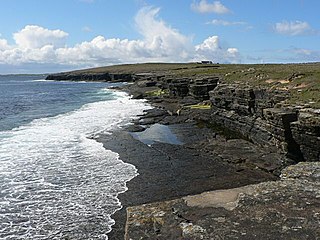
Papa Westray, also known as Papay, is one of the Orkney Islands in Scotland, United Kingdom. The fertile soil has long been a draw to the island.
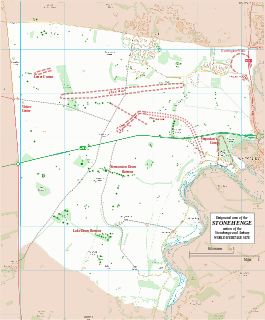
Durrington Walls is the site of a large Neolithic settlement and later henge enclosure located in the Stonehenge World Heritage Site. It lies 2 miles (3.2 km) north-east of Stonehenge in the parish of Durrington, just north of Amesbury.

Khami is a ruined city located 22 kilometres west of Bulawayo, in Zimbabwe. It was once the capital of the Kalanga Kingdom of Butwa of the Torwa dynasty. It is now a national monument, and became a UNESCO World Heritage Site in 1986.

Like other aspects of the culture of Africa, the architecture of Africa is exceptionally diverse. Throughout the history of Africa, Africans have developed their own local architectural traditions. In some cases, broader regional styles can be identified, such as the Sudano-Sahelian architecture of West Africa. A common theme in traditional African architecture is the use of fractal scaling: small parts of the structure tend to look similar to larger parts, such as a circular village made of circular houses.
Rubble is broken stone, of irregular size, shape and texture; undressed especially as a filling-in. Rubble naturally found in the soil is known also as 'brash'. Where present, it becomes more noticeable when the land is ploughed or worked.
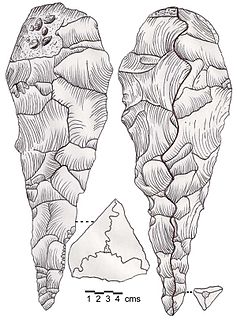
The Wall of Jericho was a Pre-Pottery Neolithic A (PPNA) defensive or flood protection wall suggested to date to approximately 8000 BCE. If interpreted as an "urban fortification", the Wall of Jericho is the oldest city wall discovered by archaeologists anywhere in the world. It is built of undressed stones and is located at the archaeological mound known as Tell es-Sultan, in the city of Jericho on the West Bank.
Sarayburnu is a promontory quarter separating the Golden Horn and the Sea of Marmara in Istanbul, Turkey. The area is where the renowned Topkapı Palace and Gülhane Park stand. Sarayburnu is included in the historic areas of Istanbul, added to the UNESCO World Heritage List in 1985.

The Antonine Wall, known to the Romans as Vallum Antonini, was a turf fortification on stone foundations, built by the Romans across what is now the Central Belt of Scotland, between the Firth of Forth and the Firth of Clyde. Representing the northernmost frontier barrier of the Roman Empire, it spanned approximately 63 kilometres and was about 3 metres high and 5 metres wide. Lidar scans have been carried out to establish the length of the wall and the Roman distance units used. Security was bolstered by a deep ditch on the northern side. It is thought that there was a wooden palisade on top of the turf. The barrier was the second of two "great walls" created by the Romans in Great Britain. Its ruins are less evident than those of the better-known Hadrian's Wall to the south, primarily because the turf and wood wall has largely weathered away, unlike its stone-built southern predecessor.
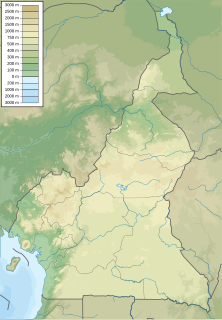
The Diy-Gid-Biy (DGB) sites are archaeological sites located around the Mandara Mountains of northern Cameroon and Nigeria, overlooking the several kilometers long Shikewe watershed. These sites get their name Diy-Gid-Biy from the Mafa language, which can be translated as "place of chiefly residence." There are 16 of these DGB sites which date back to around the 15th century AD. While knowledge of these sites has existed for some time, only in 2001 archaeologists began to investigate the sites and their cultural heritage in relation to the region.

The Lindenhof is a moraine hill and a public square in the historic center of Zürich, Switzerland. It is the site of the Roman and Carolingian era Kaiserpfalz around which the city has historically grown. The hilltop area—including its prehistoric, Roman, and medieval remains—is listed as a Swiss heritage site of national significance.

The Ness of Brodgar is an archaeological site covering 2.5 hectares between the Ring of Brodgar and the Stones of Stenness in the Heart of Neolithic Orkney World Heritage Site in Orkney, Scotland. Excavations at the site began in 2003. The site has provided evidence of decorated stone slabs, a stone wall 6 metres (20 ft) thick with foundations, and a large building described as a Neolithic temple. The earliest structures were built between 3,300 and 3,200 BC, and the site had been closed down and partly dismantled by 2,200 BC.
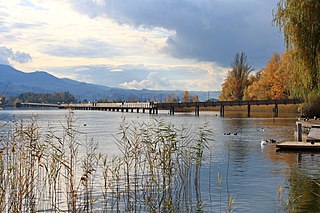
Holzbrücke Rapperswil-Hurden is a wooden pedestrian bridge between the city of Rapperswil and the village of Hurden crossing the upper Lake Zürich (Obersee) in Switzerland. The prehistoric timber piles discovered to the west of the Seedamm date back to 1523 BC. The island settlement Technikum is a prehistoric pile-dwelling settlement which is part of the UNESCO World Heritage Site Prehistoric Pile dwellings around the Alps. The first wooden footbridge led across Lake Zürich, followed by several reconstructions at least until the late 2nd century AD when the Roman Empire built a 6 metres (20 ft) wide wooden bridge. Between 1358 and 1360, Rudolf IV, Duke of Austria, built a 'new' wooden bridge across the lake that was used until 1878. On 6 April 2001, the reconstructed wooden footbridge was opened, being the longest wooden bridge in Switzerland.

Tas-Silġ is a rounded hilltop on the south-east coast of the island of Malta, overlooking Marsaxlokk Bay, and close to the town of Żejtun. Tas-Silġ is a major multi-period sanctuary site with archaeological remains covering four thousand years, from the neolithic to the fourth century AD. The site includes a megalithic temple complex dating from the early third millennium BC, to a Phoenician and Punic sanctuary dedicated to the goddess Astarte. During the Roman era, the site became an international religious complex dedicated to the goddess Juno, helped by its location along major maritime trading routes, with the site being mentioned by first-century BC orator Cicero.
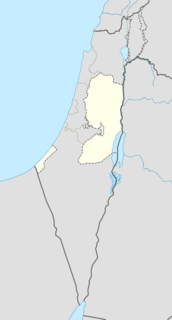
Tell es-Sultan also known as Tel Jericho or Ancient Jericho, is the site of ancient and biblical Jericho and today a UNESCO-nominated archaeological site in the West Bank, located two kilometres north of the centre of Jericho. The tell was inhabited from the 10th millennium BCE, and has been called "the oldest town in the world", with many significant archaeological finds; the site is also notable for its role in the history of Levantine archaeology.

Sa Caleta Phoenician Settlement can be found on a rocky headland about 10 kilometers west of Ibiza Town. The Phoenicians established a foothold around 650 BC. On this site archaeologists have discovered the remains of simple stone buildings. The discovery is so important that the site has been designated a World Heritage Site.
Deir el-Ballas is an archaeological site in Upper Egypt. It was the location of a royal palace and administration center occupied by rulers of the Seventeenth Dynasty in ancient Egypt's late Second Intermediate Period.

Centum Prata is the name of a Roman Vicus, whose remains are located on the eastern Zürichsee lakeshore in Kempraten, a locality of the municipality Rapperswil-Jona in the canton of St. Gallen in Switzerland. Centum Prata is the most important archaeological site from the Gallo-Roman era in the canton of St. Gallen.
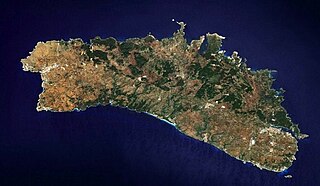
Sa Cudia Cremada is the name of an archaeological site located in a land property called in the same way, in the outskirts of the city of Mahón, the capital of Menorca.
References
- 1 2 "Kwiambana and/or Ningi". UN World Heritage Convention. Retrieved 2011-01-09.
- ↑ Patrick Darling (September 1998). "AERIAL ARCHAEOLOGY IN AFRICA: THE CHALLENGE OF A CONTINENT" (PDF). AARGnews 17. Archived from the original (PDF) on 2011-08-13. Retrieved 2011-01-09.